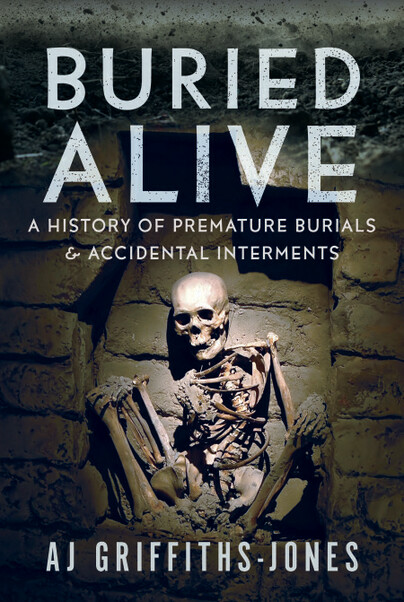Author Guest Post: AJ Griffiths-Jones
BURIED ALIVE BY A.J. GRIFFITHS-JONES
The very mention of accidental interment, or premature burial, brings a shudder to many people. The very thought of being incarcerated within an underground casket, with little air, restricted movement and the fear of no rescue, is the substance of nightmares. But scroll through the archives and you will find many instances of such cases, both by error and intentional. From the misdiagnosis of death to ritual killings by entombing victims alive, this fascinating subject is not one for the faint of heart.
Many persons have included instructions for their arteries to be severed or, in some extreme cases, for the removal of organs to ensure that death has truly taken place, and dozens of prominent figures have expressed their anxiety relating to premature burial. One such man was George Washington, who is reputed to have said, “Have me decently buried, but do not let my body be put into a vault less than two days after I am dead.” And Frederic Chopin’s last words were recorded to be, “Swear to make them cut me open, so that I won’t be buried alive.”

Sadly, years ago cases of accidental burial were not uncommon, with one of the earliest documented newspaper reports appearing in 1729, when a milkwoman’s daughter lost her life due to the disbelief of her own mother. Just as the girl was about to be interred in her coffin prior to burial, some of the mourners commented of how ‘fresh’ the corpse looked, causing one concerned relative to place a looking-glass to the girl’s lips, noting that there was a slight dew on it. The mother, however, dismissed the claim as nonsense and insisted that her daughter be buried immediately. The mourners were less convinced and called for the grave to be dug up and the coffin opened soon after interment. Tragically, the girl was found with her knees drawn upwards and her bouquet of flowers shredded to pieces as a result of the dying struggle. A surgeon was sent for, and he let the female’s blood, but it was too late, and she died soon afterwards.
Thankfully cases of people being buried alive by foul play are few and far between, but one report in 1807 saw a woman by the name of Mrs Roddy tried for wilful murder. With no apparent motive, the heinous crime of an aunt burying alive her niece shocked the small community of Meath, in Ireland, and left them reeling for many years. Suspicion has arisen when the seven-year-old child went missing and a search was made of the local area, resulting in the discovery of her body in a hole in the garden at Roddy’s home in Gaskintown.
The sentence of burying criminals alive has long been recognised in the East, with one instance recorded as early as 1810 in the London Chronicle. It was revealed that a conspiracy against the Emperor of China had been detected, in which over forty individuals were implicated. Among them were six Mandarins, particular favourites of their master. A few of the conspirators were able to make their escape, whilst several others committed suicide in order to avoid the severe punishment that they knew would be doled out. The greater number of the group, however, underwent torture before being buried alive.

There have also been hundreds of recorded cases of suttee, or sati, a Hindu practice whereby a widow sacrifices herself by lying alongside her husband on his funeral pyre or climbing into the grave next to his body as it is filled in. During the early nineteenth century several campaigners, including Ram Mohan Roy and William Carey, began to champion the banning of suttee, but for several years the number of deaths from this practice doubled. Thankfully by 1850 most states in India had successfully petitioned to abolish widow burning and burial. Regardless of the new laws, suttee deaths continued with one well-documented case occurring in 1987 when eighteen-year-old Roop Kanwar allowed herself to be buried alongside her dead husband. Although suttee is often described as a voluntary death, many eye-witness accounts mention the widows appearing to be drugged with opium before the ritual begins and others being tied up to prevent escape. Women who committed suttee in the past are still venerated in India today with the process involved being categorised in three stages:
- Having been a pativrata or dutiful wife during her husband’s life, therefore dying alongside him enables the wife to protect her spouse in the afterlife.
- Making, at her husband’s death, a solemn vow to die by his side, thus gaining status as a sativrata, a transitional stage between life and death with popular belief endowing her with supernatural powers
- Having endured being burned or buried alive, achieving the status of satimata, a spiritual embodiment of goodness with her principal concern being to protect the family.

So, we have to ask ourselves, with modern technology and medical advances, is it impossible for a person to be mistakenly certified as dead? The answer is yes, as the following 21st century cases reveal. In 2014, children were playing near a cemetery in Peraia, Thessaloniki, Greece, when they heard screams from below the earth. Police discovered that a forty-five-year old woman had been buried alive after being declared deceased by a private hospital. The cause of her actual death was pronounced as asphyxia from being trapped in the coffin. In the same year, in the same town, a forty-nine-year old woman was prematurely interred after being declared dead following cancer treatment. Her family reported hearing screams shortly after burial but by the time the coffin was opened the poor lady had died of heart failure. It was discovered that the drug administered as part of the patient’s treatment had caused a slow heartbeat, leading nurses to believe that the organ had actually stopped.

……………………………………………………….

Preorder your copy here.

